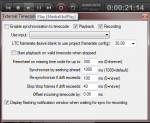I finally had a real reason to try to get my DAW to chase tape (reaper is the DAW and Tascam MS-16 is my machine).
Had a 15 track digital recording to dump to tape... so I figured I try the tips I was given and pulled out my JL Cooper PPS-1 and thought I would give this a whirl again. (Sad trombone)... PPS-1 was dead.
However I'm pretty jacked right now as I got it working without a go between box!! (other than my digital interface)
Not sure if this is only with Reaper as I don't use any other DAW (and I hardly use reaper).
I striped the tape using Reaper's timecode to track 16 of the MS-16 (at about -3 level) and then ran an out from the MS-16 to input 1 on my interface. Right clicked on the play button in Reaper to enable Reaper to look for timecode before playing and set it to look on input 1 and BAM!! Rock solid... started on time, if I FF or REW it would jump to that spot and lock almost instantaneously... didn't drift over the 3 minute test I did.
This was a big PITA when I tried it before and this was as simple as it could be.
So - if anyone wants their DAW to chase tape, get reaper and try this setup... I had it working in 3 minutes.
(FYI - I need to sync because my digital output is only 8 tracks but I can mix all 15 tracks at the same time if I dump to tape and mix through my board... would be impossible to line up the first pass with the second pass of dumping tracks to tape without this).
Hopefully it will help someone!
Had a 15 track digital recording to dump to tape... so I figured I try the tips I was given and pulled out my JL Cooper PPS-1 and thought I would give this a whirl again. (Sad trombone)... PPS-1 was dead.
However I'm pretty jacked right now as I got it working without a go between box!! (other than my digital interface)
Not sure if this is only with Reaper as I don't use any other DAW (and I hardly use reaper).
I striped the tape using Reaper's timecode to track 16 of the MS-16 (at about -3 level) and then ran an out from the MS-16 to input 1 on my interface. Right clicked on the play button in Reaper to enable Reaper to look for timecode before playing and set it to look on input 1 and BAM!! Rock solid... started on time, if I FF or REW it would jump to that spot and lock almost instantaneously... didn't drift over the 3 minute test I did.
This was a big PITA when I tried it before and this was as simple as it could be.
So - if anyone wants their DAW to chase tape, get reaper and try this setup... I had it working in 3 minutes.
(FYI - I need to sync because my digital output is only 8 tracks but I can mix all 15 tracks at the same time if I dump to tape and mix through my board... would be impossible to line up the first pass with the second pass of dumping tracks to tape without this).
Hopefully it will help someone!





